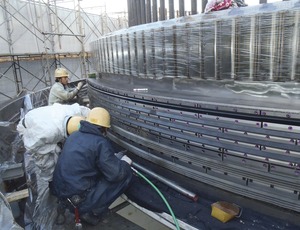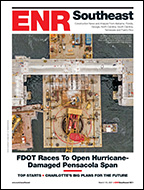
Bertha, the 57.5-ft-dia tunnel-boring machine attempting to dig a 1.7-mile state Route 99 tunnel underneath Seattle, is stuck again, having progressed 4 ft after a delay in December. Now, Seattle Tunnel Partners (STP), a joint venture of Dragados USA and Tutor Perini Corp., have decided to build a shaft in order to reach the TBM after discovering the 35-ft-dia seals surrounding the main bearing are broken.
STP and Hitachi Zosen, the Japanese manufacturer of the $80-million, 7,000-ton, 300-ft-long machine, already have started on the plan to build a 120-ft-deep, 80-ft-wide shaft in order to reach the cutter head's face 50 ft below the surface. The plan is to access Bertha from the front, instead of through the 1,023 ft already tunneled to its back end.
"If [you enter] from the tunnel on the backside of the cutter head, access is difficult. It is a cramped environment," says Chris Dixon, STP project director. "If you go down from the surface, you have more room to work, less things to remove to get out of your way and a free-air environment, so people can work regular shifts with much more efficiency."
STP and the Washington State Dept. of Transportation have both said there is no timetable on how long it will take to reach the cutter head, perform the seal repairs and get Bertha moving again, but Dixon admits "it will take months," guaranteeing delays to the $3.1-billion Alaskan Way Viaduct replacement project.
Bertha was first shut down on Dec. 6, 2013, after a high temperature and lack of progress alerted operators to an issue. Officials believed an obstruction, such as a glacial boulder, caused the blockage. The machine had been performing better than expected, advancing 30 ft per day.
Drilled test shafts and 158 hours of hyperbaric inspections found no obstruction, although the cutter-head tools were damaged and clogged with dirt. STP and WSDOT discovered an 8-in.-dia steel well casing during inspections. STP says the casing stopped Bertha, but WSDOT disagrees.
Crews tried to move Bertha again on Jan. 28 but shut her down on Jan. 29, after only 4 ft, due to internal machine temperature readings of 140°F, over 1.5 times the normal level.
Further investigation found the broken main bearing seals, although STP says the main bearing isn't damaged. Since broken main bearings are not uncommon on TBMs, the design-build contract stipulates a second main bearing must sit at the ready. Bertha is designed so that, at any point during the project, the main bearing can be replaced from within the tunnel and through the back.
That $5-million part, manufactured by German-based Rothe Erde, can arrive, if needed, for installation by the time the necessary work is done, says Todd Trepanier, WSDOT's Alaskan Way Viaduct Replacement program administrator. But for now, the plan is to replace the rubberized seals, which ensure grease limits friction and heat inside the machine. Dixon says the main bearing will get recertified before Bertha moves again.
Dixon says STP does not take "final acceptance" of the machine until 200 concrete liner rings are placed, so after 150 rings, Bertha is still under warranty from Hitachi Zosen. The final 10% payment to Hitachi isn't due until final acceptance.




Post a comment to this article
Report Abusive Comment